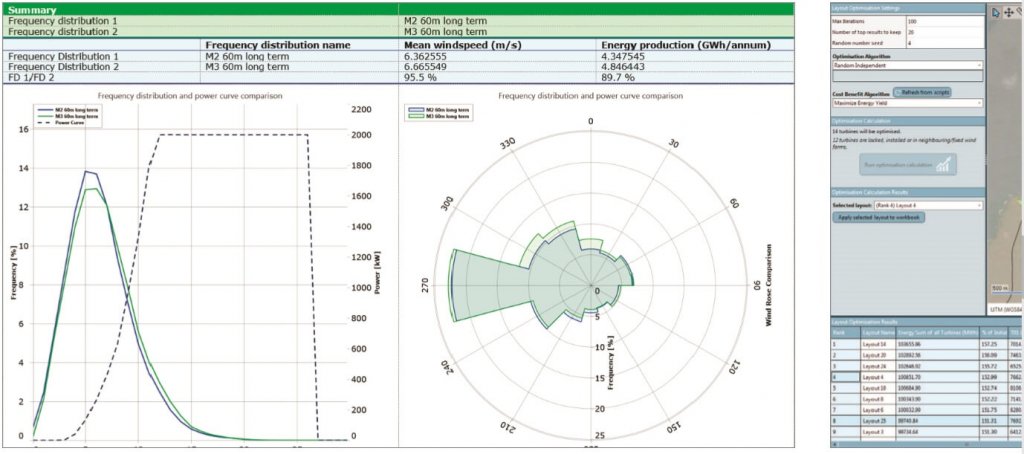Warwick Elkins, Senior Engineer, Project Development, DNV GL
If the wind industry is to account for a predicted 36.4% of the energy mix by 2050, large step-ups in process efficiency are needed to ensure that today’s cost-reduction trends continue. At the design stage, a drive for efficiency will emanate through wind-farm development providing more certainty in its financial models to bring more projects successfully through to close.
WindFarmer: Analyst, a new energy analysis software product from DNV GL, provides developers with more certainty and drives efficiency further than has been previously possible. It empowers our consultants with an ability to make energy assessments with increased accuracy, efficiency, and repeatability. Then, by sharing this platform, customers have the opportunity to reduce the disparity between their design phase predictions and our final bankable numbers.

The top panel plots time series data collected from several locations and with different sensors over a particular site. The bottom panel shows ratio plots between parallel sensors, with valid data in blue and excluded data in orange.
The new software incorporates all elements of an energy-assessment process with a focus on usability, automation, and accuracy.
Usability
When development of the software began, we gathered users together and mapped all the tasks they need to do. We refined this map and tried to look past what we do today, towards the fundamental activities in their analysis. The design concept behind WindFarmer: Analyst was to follow these activities and make them intuitive. The final design is comprised of chapters, and within each chapter are a series of tasks in which users are supplied with only the relevant visualizations and tools. This lets analysts quickly adopt the tool with little training. A few key features include a:
- Map setup which defines co-ordinate systems and downloads or imports GIS data.
- Measurement site setup defines the physical specifications of the equipment that recorded the wind measurements. Create settings files to import time series wind data in many formats, correct time offsets and re-calibrate mis-programmed loggers.
- Cleaning measured data allows visualizing and exploring time-series data to find sensor malfunctions and remove these from the analysis.
- Long-term and shear calculations use DNV GL’s methodology to define relationships that ensure climate predictions represent long-term expectations for the hub-height of the chosen turbines.
- Site setup configures turbine types and locations in the wind farms. It also defines air density and enables wind-sector management turbine shutdown rules to be applied.
- Flow model lets users import their own flow model results, or automate WAsP, the industry standard linear wind flow model, without having to leave the WindFarmer: Analyst user interface.
- Energy calculation defines settings and runs validated energy and wake models. Users then review the results.
- Optimization helps users design a better wind farm layout within their constraints by iterating through hundreds of possible turbine positions until maximum energy is achieved.
- Reporting exports data and produces attractive, informative reports.
Automation
In addition, a powerful C# scripting module facilitates the automation of any function within WindFarmer: Analyst. Scripting gives the user many possibilities for automating repetitive tasks, extending user interface functions, and even connecting with external tools.

The two plots present wind data. The left window compares the energy content of measured and synthesized frequency distributions for concurrent periods. The wind roses on the right present the check on a directional basis.
Scripting is also where users perform complex procedures on their cleaned wind time-series data to predict the long-term, hub-height wind climate at each measurement site. These wind climate predictions are key inputs in the wind flow, wake, and energy modeling.

A few of the optimization functions appear here. For this exercise, 14 turbines will be optimized while 12 neighboring turbine positions are locked.
The layout optimizer in the software links directly with the scripting feature and allows changing the maximum energy yield target to a user’s cost-benefit algorithm. Furthermore, scripting can be used to connect the optimizer to other DNV GL software products, such as Bladed and the Site Suitability Tool, so that every layout iteration can be checked for ‘pass’ or ‘fail’ against the load design parameters for a specific turbine model.
Users have access to example scripts and tutorials. The company also provides custom script writing as a service to tailor the software to individual requirements.
Accuracy
Amidst the array of new features, the software is built on the firm’s widely validated wake and energy models. These have migrated from its predecessor WindFarmer 5.3, which has supported over 200 GW of pre-construction wind farm analyses globally performed by DNV GL.

The performance of the wind flow model is reviewed from any reference wind direction. The predicted mean free wind speed is idsplayed at six turbine locations.
In 2018, we will introduce advanced turbine mode switching, time series energy analysis, and the automatic download of Virtual Met Data and satellite reference data. Also, we will shortly deploy a link between WindFarmer: Analyst and our online data management service, Resource Panorama, so users can schedule the download of professionally cleaned wind data into their workspace.
Beyond 2018, we see this analytical software providing improved process efficiency and reliability to ensure the wind industry delivers a smarter and greener future.
Filed Under: Uncategorized





